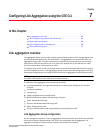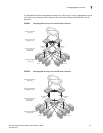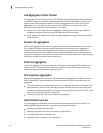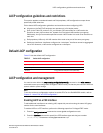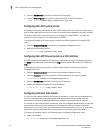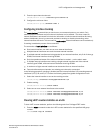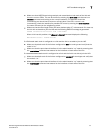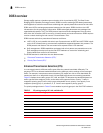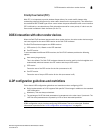72 Dell Converged Enhanced Ethernet Administrator’s Guide
53-1002116-01
LACP troubleshooting tips
7
Clearing LACP counter statistics on all LAG groups
To clear LACP counter statistics, enter the clear command to clear the LACP counter statistics for all
LAG groups.
Example
switch#clear lacp counters
Displaying LACP information
Use the show command to display LACP statistics and configuration information. See the
Converged Enhanced Ethernet Command Reference for information.
LACP troubleshooting tips
To troubleshoot problems with your LACP configuration, use the following troubleshooting tips.
If a standard IEEE 802.3ad-based dynamic trunk is configured on a link and the link is not able to
join the LAG:
• Make sure that both ends of the link are configured as standard for the trunk type.
• Make sure that both ends of the link are not configured for passive mode. They must be
configured as either active/active, active/passive, or passive/active.
• Make sure that the port-channel interface is in the administrative “up” state by ensuring that
the no shutdown command was entered on the interface on both ends of the link.
• Make sure that the links that are part of the LAG are connected to the same neighboring
switch.
• Make sure that the system ID of the switches connected by the link is unique. This can be
verified by entering the show lacp sys-id command on both switches.
• Make sure that LACPDUs are being received and transmitted on both ends of the link and that
there are no error PDUs. This can be verified by entering the show lacp counters
port-channel-num command and looking at the receive mode (rx) and transmit mode (tx)
statistics. The statistics should be incrementing and should not be at zero or a fixed value. If
the PDU rx count is not incrementing, check the interface for possible CRC errors by entering
the show interface link-name command on the neighboring switch. If the PDU tx count is not
incrementing, check the operational status of the link by entering the show interface link-name
command and verifying that the interface status is “up.”
If a Dell-based dynamic trunk is configured on a link and the link is not able to join the LAG:
• Make sure that both ends of the link are configured as Dell for trunk type.
• Make sure that both ends of the link are not configured for passive mode. They must be
configured as either active/active, active/passive, or passive/active.
• Make sure that the port-channel interface is in the administrative “up” state by ensuring that
the no shutdown command was entered on the interface on both ends of the link.
• Make sure that the links that are part of the LAG are connected to the same neighboring
switch.
• Make sure that the system ID of the switches connected by the link is unique. This can be
verified by entering the show lacp sys-id command on both switches.




